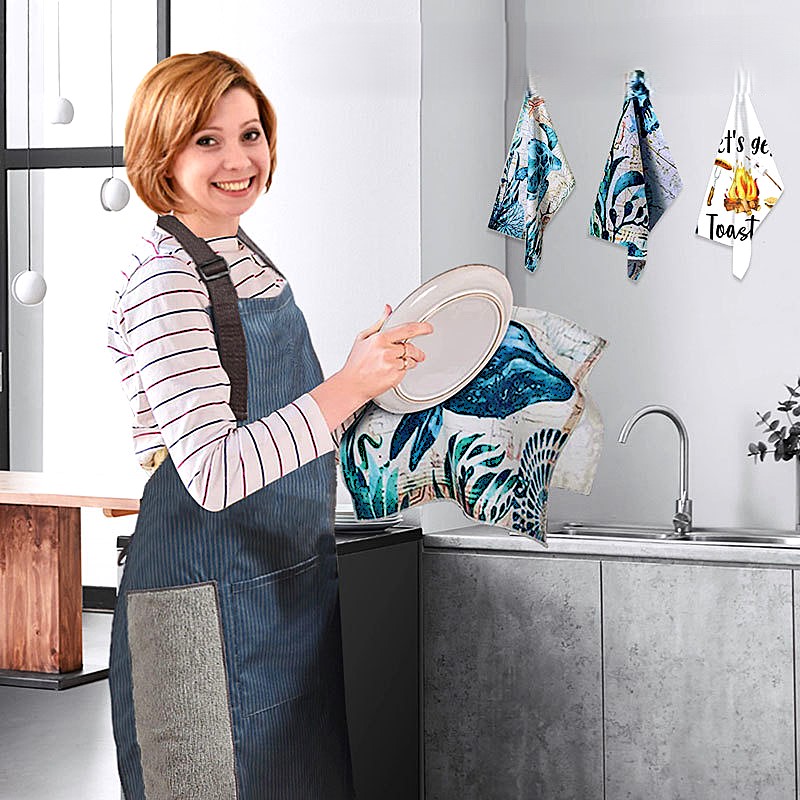Microfiber Towel: Guide to Benefits, Types & Uses (2025)
| Quick Facts | Details |
|---|---|
| What is it? | Ultra-fine synthetic fiber towel made from polyester and polyamide blend |
| Key Benefits | 7x more absorbent than cotton, quick-drying, lint-free, scratch-free |
| Best Uses | Cleaning, automotive detailing, beach/travel, sports, household |
| Lifespan | 500+ washes with proper care |
| Price Range | $2-$25 per towel depending on size, quality, and customization |
| GSM Range | 200-600 GSM (grams per square meter) |
📊 Global Microfiber Towel Market Snapshot 2025
Sources: GrowthMarketReports, FutureMarketInsights, BusinessResearchInsights
Looking for the perfect microfiber towel that combines quality, durability, and performance? Whether you’re cleaning your car, heading to the beach, or running a business that needs wholesale towels, understanding what makes a great microfiber towel is essential. In this comprehensive guide, we’ll explore everything you need to know about microfiber towels, from their construction to their countless uses. Moreover, you’ll discover why these innovative towels have revolutionized the cleaning and textile industry.
What is a Microfiber Towel?
A microfiber towel is a specialized cleaning and drying cloth made from incredibly fine synthetic fibers. Specifically, these fibers are much thinner than a human hair—less than one denier in thickness. To put it simply, one denier equals the mass in grams of 9,000 meters of fiber. Therefore, microfiber is exceptionally fine and delicate.
Unlike traditional cotton towels, microfiber towels are made from a blend of polyester (typically 80%) and polyamide or nylon (typically 20%). Additionally, during the manufacturing process, these fibers are split to create microscopic hooks and wedges. As a result, this unique structure dramatically increases the surface area of each fiber.
How Microfiber Towels Work
The secret behind microfiber’s superior performance lies in its structure. First, each fiber is split into dozens of smaller strands during production. Then, these split fibers create a star-shaped cross-section with multiple wedges. Consequently, this design allows microfiber towels to:
- Trap and lift dirt particles instead of pushing them around the surface
- Absorb up to 7 times their weight in water, making them incredibly efficient
- Clean without chemicals because the fibers mechanically remove dirt and bacteria
- Dry quickly due to their synthetic composition and increased surface area
- Leave surfaces streak-free and lint-free, which is perfect for glass and mirrors
“The ultra-fine fibers in microfiber towels create millions of tiny pockets that attract and hold dust, dirt, and moisture like a magnet. This makes them far more effective than traditional cotton towels for cleaning.” – EPA Green Cleaning Guide
Quick Comparison: Microfiber vs. Cotton Towels
| Feature | Microfiber Towel | Cotton Towel |
|---|---|---|
| Absorbency | 7x its weight in water | 3x its weight in water |
| Drying Time | 30 minutes to 2 hours | 4-8 hours |
| Lint Production | Lint-free | Leaves lint behind |
| Durability | 500+ washes | 200-300 washes |
| Weight (when dry) | Lightweight | Heavier |
| Cleaning Power | Traps dirt mechanically | Pushes dirt around |
Top 7 Benefits of Using Microfiber Towels
Why have microfiber towels become so popular across industries and households worldwide? The answer lies in their remarkable benefits. Let’s explore the top seven advantages that make these towels a superior choice.
1. Superior Absorbency (7x Water Weight)
First and foremost, microfiber towels can absorb up to seven times their weight in water. In comparison, traditional cotton towels typically absorb only two to three times their weight. Therefore, this means faster drying times and more efficient cleaning. For instance, when you’re drying your car after washing it, a microfiber towel will soak up water much faster than cotton alternatives.
2. Lint-Free and Scratch-Free Cleaning
Additionally, one of the most frustrating problems with regular towels is lint. However, microfiber towels are completely lint-free, making them perfect for cleaning glass, mirrors, and electronics. Moreover, their soft fibers won’t scratch delicate surfaces like car paint, smartphone screens, or eyeglasses. As a result, professional detailers and cleaning services prefer microfiber for premium results.
3. Quick-Drying Properties
Furthermore, synthetic fibers dry much faster than natural fibers. Specifically, microfiber towels can air-dry in 30 minutes to 2 hours, depending on thickness and humidity. On the other hand, cotton towels often take 4-8 hours or longer. Consequently, this quick-drying feature prevents musty odors and bacterial growth, making them more hygienic overall.
4. Durability and Longevity (500+ Uses)
When properly cared for, quality microfiber towels can last through 500 or more wash cycles. In contrast, cotton towels typically deteriorate after 200-300 washes. Therefore, although microfiber may cost more initially, the long-term value is significantly better. Additionally, high-quality towels from reputable manufacturers like Favor Houseware maintain their effectiveness even after hundreds of uses.
5. Eco-Friendly and Reusable
From an environmental perspective, microfiber towels are more sustainable than disposable cleaning products. Specifically, they eliminate the need for paper towels, which create significant waste. Moreover, microfiber cleans effectively with just water, reducing chemical usage. According to EPA guidelines, using reusable microfiber can significantly reduce environmental impact in both homes and commercial facilities.
6. Versatile for Multiple Uses
Another great advantage is versatility. Indeed, microfiber towels work brilliantly for:
- Household cleaning – kitchens, bathrooms, floors, and furniture
- Automotive detailing – washing, drying, and polishing cars
- Beach and travel – lightweight, compact, sand-resistant options like sand-free beach towels
- Sports and fitness – gym towels, yoga mats, and cooling sports towels
- Personal care – hair drying, facial cleansing, and spa treatments
7. Cost-Effective Over Time
Finally, while the upfront cost might be higher, microfiber towels save money long-term. Because they last longer, clean more effectively, and reduce the need for cleaning chemicals, your total cost of ownership decreases significantly. For businesses, purchasing wholesale from manufacturers like Favor Houseware makes them even more economical.
Types of Microfiber Towels: Which One Do You Need?
Not all microfiber towels are created equal. In fact, different types are designed for specific purposes. Understanding these variations helps you choose the right towel for your needs. Let’s break down the main categories.
Types By Weave Pattern
The weave pattern affects how the towel performs. Therefore, choosing the right weave is crucial for your intended use.
Waffle Weave Microfiber Towels
First, waffle weave towels feature a textured, grid-like pattern. Consequently, this design creates pockets that trap water and dirt exceptionally well. Moreover, they’re perfect for:
- Drying cars without streaks
- Glass and window cleaning
- Drying dishes and glassware
- General household drying tasks
Twist Loop Microfiber Towels
Next, twist loop towels have longer fibers twisted into loops. As a result, they provide extra plushness and absorbency. Additionally, they’re ideal for:
- Drying hair gently without damage
- Bath and beach use for maximum absorption
- Spa and salon applications
- Pet drying after baths
Plush/Terry Microfiber Towels
Furthermore, plush microfiber towels mimic traditional terry cloth but with microfiber benefits. Therefore, they offer softness combined with superior performance. Popular applications include:
- Microfiber beach towels for comfort and quick drying
- Bath towels for everyday home use
- Hotel and hospitality industries
Suede Microfiber Towels
Lastly, suede microfiber has a smooth, flat surface. Consequently, it’s extremely gentle and won’t scratch sensitive surfaces. Therefore, it’s perfect for:
- Polishing car paint and chrome
- Cleaning electronic screens and lenses
- Jewelry and delicate instrument cleaning
Types By GSM Weight
GSM (grams per square meter) indicates the density and thickness of the towel. Generally speaking, higher GSM means thicker, more absorbent towels. However, different tasks require different GSM levels.
| GSM Range | Description | Best For | Examples |
|---|---|---|---|
| 200-300 GSM | Lightweight, thin, quick-drying | Cleaning, polishing, travel | Window cleaning, travel towels, dusting cloths |
| 300-400 GSM | Medium weight, balanced performance | General purpose, automotive, beach | Car drying, beach towels, gym towels |
| 400-600 GSM | Heavy, plush, maximum absorbency | Drying, bath, premium applications | Bath towels, luxury beach towels, spa towels |
| 600+ GSM | Ultra-plush, luxury grade | Premium bath, high-end hospitality | 5-star hotels, luxury spas, premium gifts |
Types By Specific Purpose
Finally, many microfiber towels are designed for specific applications. Here are the most common types:
- Cleaning Towels: General-purpose household cleaning (200-350 GSM)
- Automotive Towels: Car washing, drying, and detailing (300-500 GSM)
- Beach Towels: Sand-resistant, lightweight, quick-dry like round beach towels (300-400 GSM)
- Sports Towels: Gym, yoga, and cooling towels for athletes (250-350 GSM)
- Hair Towels: Gentle hair drying, turban-style wraps (300-400 GSM)
- Travel Towels: Compact, ultra-lightweight for backpacking (200-300 GSM)

Premium custom microfiber towels with digital printing – no MOQ required
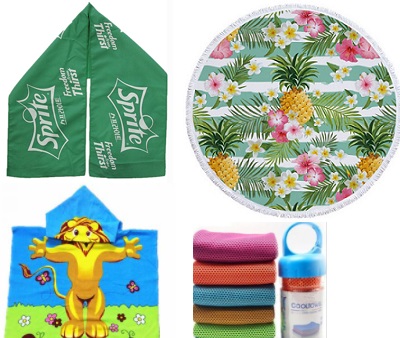
Wholesale microfiber towels for businesses – MOQ starts from 100 pieces
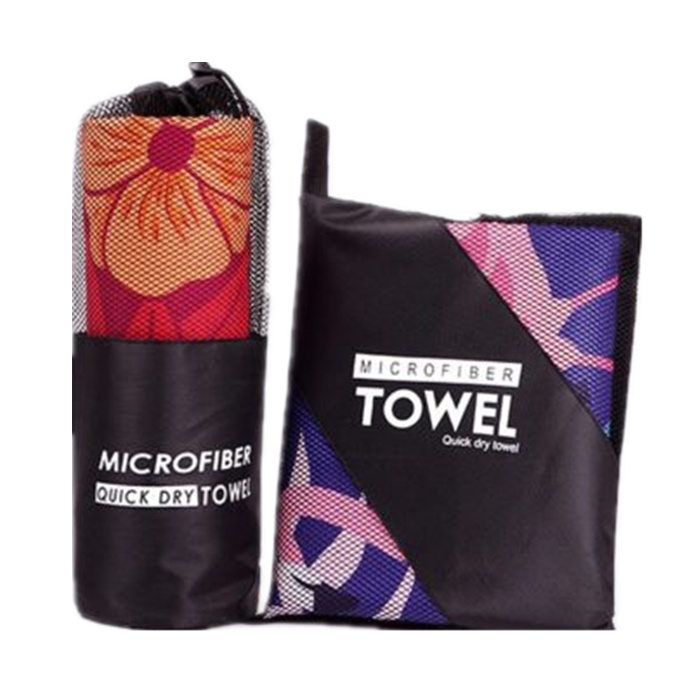
Quick-dry microfiber beach towels perfect for travel and outdoor activities
How Microfiber Towels Are Made: Materials and Manufacturing Process
Understanding how microfiber towels are manufactured helps you appreciate their quality and performance. Moreover, knowing the production process enables you to identify high-quality towels when purchasing. Let’s explore the journey from raw materials to finished product.
Materials Used in Microfiber Production
As mentioned earlier, microfiber towels consist primarily of two synthetic materials:
Polyester (70-80%)
First, polyester forms the bulk of microfiber fabric. Specifically, it provides:
- Durability and strength for long-lasting performance
- Quick-drying properties that prevent mildew
- Color retention so towels stay vibrant longer
- Cost-effectiveness for affordable production
Polyamide/Nylon (20-30%)
Next, polyamide (also called nylon) adds crucial properties:
- Enhanced absorbency for better water retention
- Softness that feels gentle on surfaces
- Improved cleaning ability through electrostatic attraction
- Flexibility that allows fibers to trap particles effectively
“The ideal blend ratio for premium microfiber towels is 80% polyester and 20% polyamide. This combination maximizes both durability and absorbency.” – Textile Technology Institute
The Manufacturing Process: Step by Step
Professional manufacturers like Favor Houseware Co., Ltd. in Yiwu, Zhejiang Province, China, follow a precise manufacturing process. With 15 years of experience, they’ve perfected each step to ensure consistent quality.
Step 1: Fiber Production and Splitting
First, polyester and polyamide polymers are melted and extruded through tiny holes to create ultra-fine fibers. Then, these fibers undergo a splitting process where each fiber is divided into multiple smaller strands. Consequently, this creates the characteristic wedge shape that gives microfiber its unique properties.
Step 2: Weaving
Next, the split fibers are loaded onto advanced weaving machines. At this stage, imported weaving machines ensure consistent density and precise patterns. Moreover, the weaving pattern (waffle, plush, suede, etc.) is determined here. Additionally, the GSM weight is controlled by adjusting fiber density during weaving.
Step 3: Digital Printing and Design
After weaving, many towels receive custom designs through digital printing. Importantly, modern manufacturers like Favor Houseware offer digital printing with no minimum order quantity (MOQ). Therefore, even small businesses can create fully customized microfiber towels with:
- Full-color logos and branding
- Custom patterns and artwork
- Photo-realistic images
- Unlimited color options
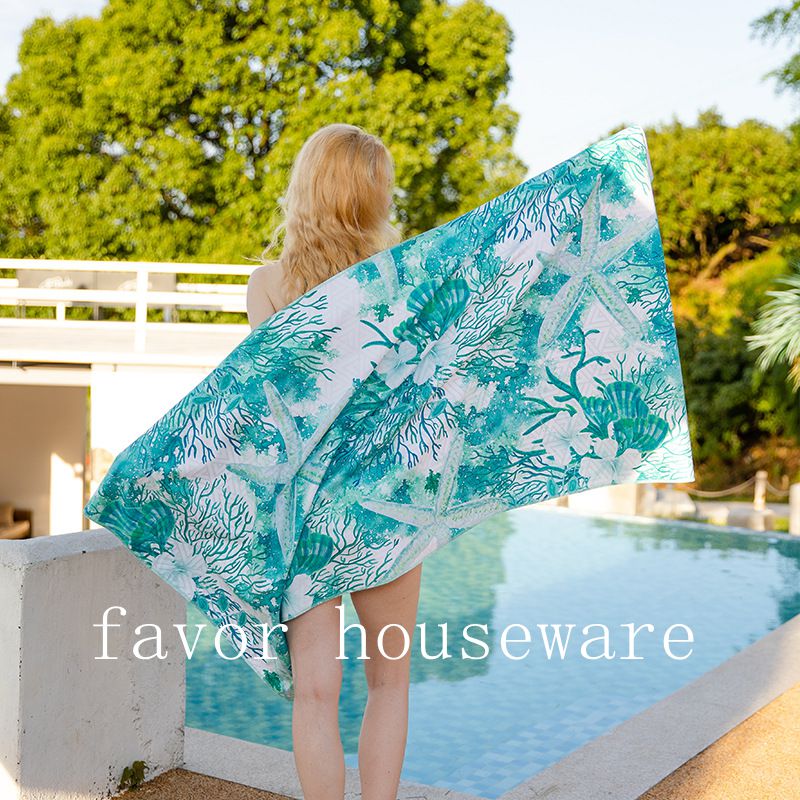
State-of-the-art manufacturing facility with imported weaving equipment
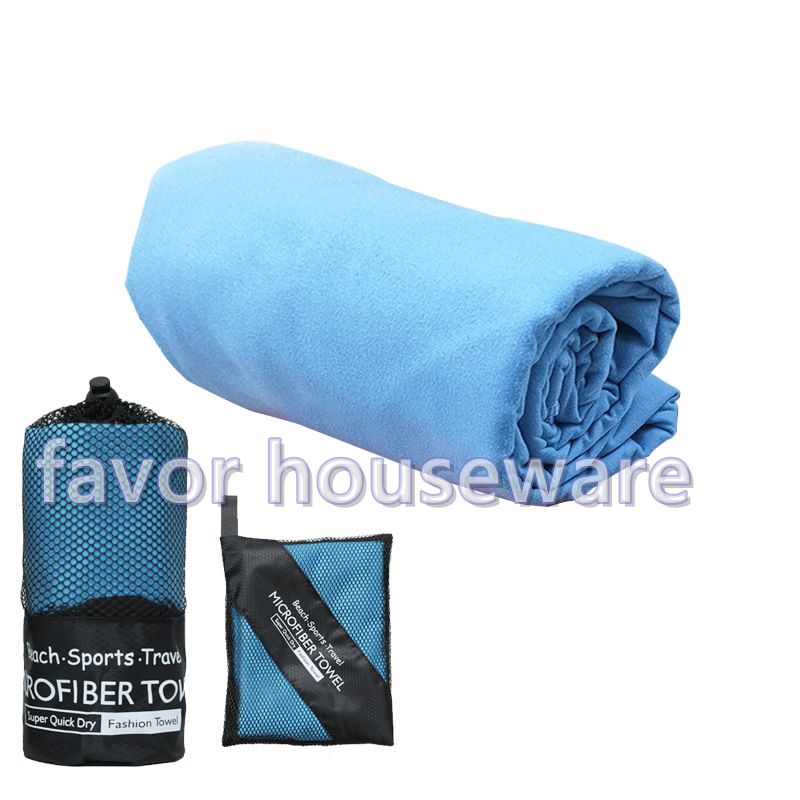
Strict quality inspection ensures every towel meets international standards

Digital printing capabilities for unlimited customization possibilities
Step 4: Cutting to Size
Subsequently, the fabric is precisely cut to specified dimensions. Whether it’s small cleaning cloths or large Turkish beach towels, accurate cutting ensures consistency across batches. Furthermore, computerized cutting systems minimize waste and maintain quality.
Step 5: Sewing and Edge Finishing
Following cutting, automatic sewing machines create durable seams and hem edges. Specifically, quality manufacturers use:
- Double-stitched edges for extra durability
- Overlocked seams that prevent fraying
- Reinforced corners on larger towels
- Optional decorative stitching for premium products
Step 6: Quality Inspection
Before packing, every towel undergoes strict quality inspection. Indeed, reputable manufacturers check for:
- Consistent GSM weight across the entire towel
- Printing quality and color accuracy
- Seam strength and edge integrity
- Absence of defects, holes, or irregularities
- Proper sizing and measurements
According to industry standards from ASTM International, quality microfiber should meet specific performance criteria including absorbency rates, durability, and cleaning efficiency.
Step 7: Packing and Shipping
Finally, inspected towels are carefully packe
